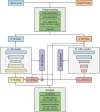Deep attention super-resolution of brain magnetic resonance images acquired under clinical protocols
- PMID: 36093418
- PMCID: PMC9458316
- DOI: 10.3389/fncom.2022.887633
Deep attention super-resolution of brain magnetic resonance images acquired under clinical protocols
Abstract
Vast quantities of Magnetic Resonance Images (MRI) are routinely acquired in clinical practice but, to speed up acquisition, these scans are typically of a quality that is sufficient for clinical diagnosis but sub-optimal for large-scale precision medicine, computational diagnostics, and large-scale neuroimaging collaborative research. Here, we present a critic-guided framework to upsample low-resolution (often 2D) MRI full scans to help overcome these limitations. We incorporate feature-importance and self-attention methods into our model to improve the interpretability of this study. We evaluate our framework on paired low- and high-resolution brain MRI structural full scans (i.e., T1-, T2-weighted, and FLAIR sequences are simultaneously input) obtained in clinical and research settings from scanners manufactured by Siemens, Phillips, and GE. We show that the upsampled MRIs are qualitatively faithful to the ground-truth high-quality scans (PSNR = 35.39; MAE = 3.78E-3; NMSE = 4.32E-10; SSIM = 0.9852; mean normal-appearing gray/white matter ratio intensity differences ranging from 0.0363 to 0.0784 for FLAIR, from 0.0010 to 0.0138 for T1-weighted and from 0.0156 to 0.074 for T2-weighted sequences). The automatic raw segmentation of tissues and lesions using the super-resolved images has fewer false positives and higher accuracy than those obtained from interpolated images in protocols represented with more than three sets in the training sample, making our approach a strong candidate for practical application in clinical and collaborative research.
Keywords: Magnetic Resonance Imaging; U-Net; brain imaging; deep learning; explainable artificial intelligence; generative adversarial networks; image reconstruction; super-resolution.
Copyright © 2022 Li, Castorina, Valdés Hernández, Clancy, Wiseman, Sakka, Storkey, Jaime Garcia, Cheng, Doubal, Thrippleton, Stringer and Wardlaw.
Conflict of interest statement
The authors declare that the research was conducted in the absence of any commercial or financial relationships that could be construed as a potential conflict of interest.
Figures













Similar articles
-
[Multimodality-based super-resolution reconstruction for routine brain magnetic resonance images].Nan Fang Yi Ke Da Xue Xue Bao. 2022 Jul 20;42(7):1019-1025. doi: 10.12122/j.issn.1673-4254.2022.07.08. Nan Fang Yi Ke Da Xue Xue Bao. 2022. PMID: 35869764 Free PMC article. Chinese.
-
Unsupervised arterial spin labeling image superresolution via multiscale generative adversarial network.Med Phys. 2022 Apr;49(4):2373-2385. doi: 10.1002/mp.15468. Epub 2022 Mar 7. Med Phys. 2022. PMID: 35048390
-
MRI super-resolution reconstruction for MRI-guided adaptive radiotherapy using cascaded deep learning: In the presence of limited training data and unknown translation model.Med Phys. 2019 Sep;46(9):4148-4164. doi: 10.1002/mp.13717. Epub 2019 Aug 7. Med Phys. 2019. PMID: 31309585
-
Reconstruction of multicontrast MR images through deep learning.Med Phys. 2020 Mar;47(3):983-997. doi: 10.1002/mp.14006. Epub 2020 Jan 28. Med Phys. 2020. PMID: 31889314
-
Super-resolution reconstruction in frequency, image, and wavelet domains to reduce through-plane partial voluming in MRI.Med Phys. 2015 Dec;42(12):6919-32. doi: 10.1118/1.4935149. Med Phys. 2015. PMID: 26632048 Free PMC article.
Cited by
-
Mouse brain MR super-resolution using a deep learning network trained with optical imaging data.Front Radiol. 2023 May 15;3:1155866. doi: 10.3389/fradi.2023.1155866. eCollection 2023. Front Radiol. 2023. PMID: 37492378 Free PMC article.
-
Reducing the acquisition time for magnetic resonance imaging using super-resolution image generation and evaluating the accuracy of hippocampal volumes for diagnosing Alzheimer's disease.Front Neurol. 2025 Jul 15;16:1507722. doi: 10.3389/fneur.2025.1507722. eCollection 2025. Front Neurol. 2025. PMID: 40734823 Free PMC article.
References
-
- Bansal A., Ma S., Ramanan D., Sheikh Y. (2018). “Recycle-gan: unsupervised video retargeting,” in Proceedings of the European Conference on Computer Vision (ECCV) (Munich: ), 119–135.
-
- Bergstra J., Bengio Y. (2012). Random search for hyper-parameter optimization. J. Mach. Learn. Res. 13, 281–305.
-
- Bernal J., Valdés-Hernández M. d. C., Ballerini L., Escudero J., Jochems A. C., Clancy U., et al. . (2020). “A framework for jointly assessing and reducing imaging artefacts automatically using texture analysis and total variation optimisation for improving perivascular spaces quantification in brain magnetic resonance imaging,” in Annual Conference on Medical Image Understanding and Analysis (Oxford: Springer; ), 171–183.
-
- Bernal J., Valdés-Hernández M. d. C., Escudero J., Armitage P. A., Makin S., et al. . (2019). “Analysis of spatial spectral features of dynamic contrast-enhanced brain magnetic resonance images for studying small vessel disease,” in Annual Conference on Medical Image Understanding and Analysis (Liverpool: Springer; ), 282–293.
LinkOut - more resources
Full Text Sources

